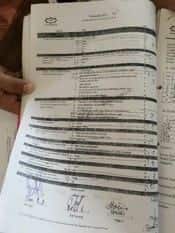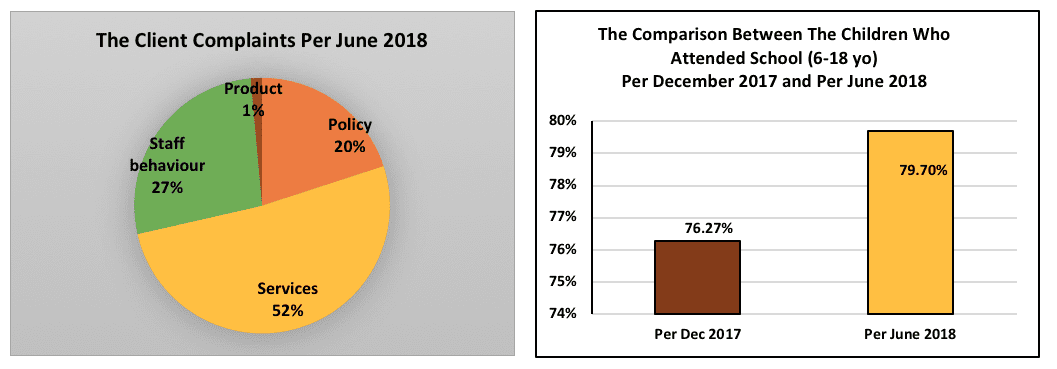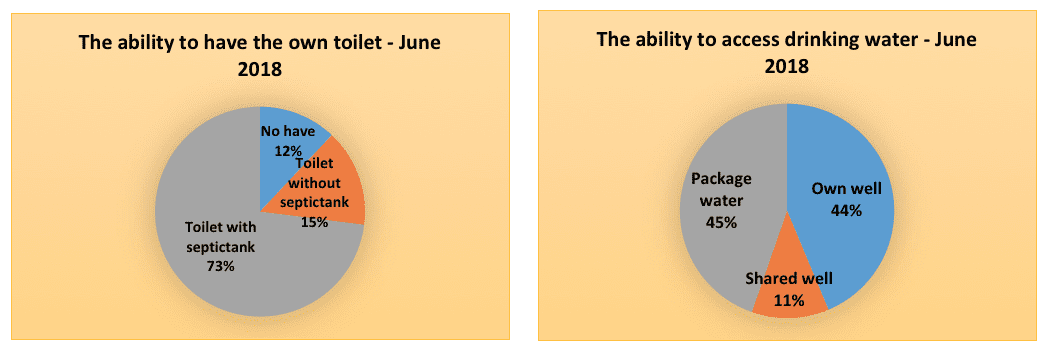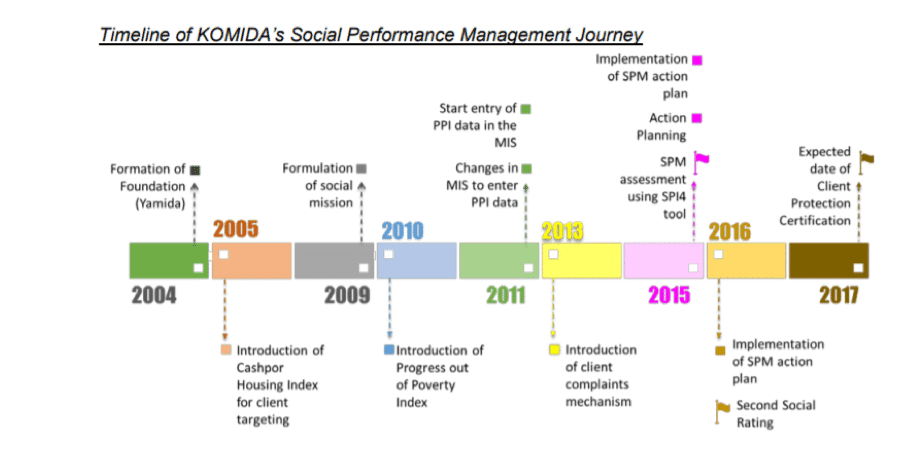KOMIDA: Investing in a Future without Poverty in Indonesia
As part of Whole Planet Foundation’s annual due diligence visits to our microfinance partners around the globe, we observe the presence or absence of “responsible finance indicators” which shed light on how our partners are serving the world’s poorest people. Many of our microfinance partners use or develop strategies to inform their work, ensuring they are reaching their target populations with the services they need most.
Whole Planet Foundation’s Indonesian partner, KOMIDA, was recently highlighted in a case study featured on Microfinance Gateway for their work in the field of Social Performance Management. As it pertains to microfinance institutions (MFIs), CGAP defines Social Performance Management as: “…the systems that organizations use to achieve their stated social goals and put customers at the center of strategy and operations. A provider’s social performance refers to its effectiveness in achieving its stated social goals and creating value for clients.”
KOMIDA operates out of 230 branches in 11 provinces: Aceh, Banten, West Java, Central Java, East Java, Yogyakarta, West Nusa Tenggara, East Nusa Tenggara, South Sulawesi, West Sulawesi, and South Kalimantan. As of June 2018, KOMIDA had over 487,226 active borrowers and a loan portfolio of over $60 million. This makes KOMIDA the second largest microfinance institution in Indonesia.
A Focus on the Poorest Populations
KOMIDA started offering microfinance services in 2005 to help tsunami victims in Aceh, Indonesia. The organization has steadily built on this social focus. When they first began their work, KOMIDA used a questionnaire called the Cashpor Housing Index (CHI) to help them appropriately target clients. In mid-2017 KOMIDA reviewed the CHI, and after discussion by management, KOMIDA decided to change some CHI indicators in order to adjust to the condition of Indonesian society. Their new system is now called the KHI (KOMIDA House Index), and it is currently under a review process in new branches.
The KHI requires field staff to ask clients about the height of their home’s walls and materials of their home’s construction. The KHI is based on the fact that poor people tend to spend their money first on basic needs, then social obligations, and finally on housing. Therefore, the KHI reveals not only the quality of the house, but is also an indicator of the wealth of the household itself.

The PPI at KOMIDA
In addition to the KHI, the Poverty Probability Index (PPI) is another tool that can be used to identify and measure the poverty level of incoming clients. The PPI asks a series of questions about the type of housing, assets of the household and education of the family. Each answer has a score and these are totaled together. The score is then coded to a look-up table where it can be matched with a percentage indicating the likelihood that this household is living below the poverty line. The PPI is updated and modified for each country to be aligned with the specific context, and as of June 2018, KOMIDA reached 6.5% clients living below the National Poverty Line of Indonesia. 9.8% of their clients are living below $1.25 USD/day and 64.8% of clients are living on less than $2.50 USD/day.
From 2009 until 2018, KOMIDA adapted the PPI and also refined their mission statement. The management team demonstrates full commitment to achieving their social goals, especially at a time where different forms of lending could be more commercially viable for the organization. KOMIDA’s use of the PPI is a critical part of this mission. Their use of the Index ensures they cater to women below the poverty level to create programs and products that make a difference in improving their livelihoods.
Social Performance Management
In 2015, KOMIDA created a Social Performance Management (SPM) team, including a SPM champion on their board of directors. Another focus during this period was implementing client protection principles. These steps included developing an SMS number for customer feedback, responsible pricing, feedback surveys for product development and a focus on increasing staff retention rate. KOMIDA also conducts client satisfaction surveys in order to get information and feedback from clients about their preferences and complaints so they can better meet their clients’ needs. This is done as part of KOMIDA’s commitment to the SMART Campaign’s 7 Client Protection Principles.
Here is a snapshot of some of the Social Indicators which KOMIDA follows:


In 2015, KOMIDA engaged with Opportunity International for technical assistance to evaluate KOMIDA’s social performance using a social audit tool. As Annadanam explains in the CGAP case study, there were four main reasons why KOMIDA decided to implement the Universal Standards for SPM:
-
- To hold itself accountable to its social mission. KOMIDA genuinely wanted to create positive effects in clients’ lives, and it recognized that good SPM would help it to achieve its goals.
- To understand what outcomes KOMIDA’s clients had actually been experiencing. The board, management, and staff felt that there was no proof beyond the anecdotal evidence that they had gathered about how KOMIDA’s services were affecting clients’ lives. KOMIDA knew that implementing SPM would help the team get a true understanding of how clients’ lives were changing, for better or worse.
- To understand to what extent KOMIDA was complying with the global standards of SPM. This is a topic of increasing relevance to funders and regulators around the world.
- To respond to social investors’ requests for SPM data that went beyond the PPI. While the PPI is a great tool to understand the poverty levels of clients, other SPM data are required to understand all of the changes (meaning, outcomes) taking place. For instance, investors wanted additional data related to children’s education, health outcomes, and household income improvements. Furthermore, KOMIDA did not have data on the quality of services, except for the proxy of client exit rate, and it lacked data on client satisfaction and client complaint resolution” (6).
After receiving the scores and analysis from the audit process, KOMIDA engaged their team across all departments and modified the organization’s strategy by creating an action plan. This was an iterative process taking place from 2015-2016. KOMIDA paid all the costs of implementing the action plan and acted carefully to make it as affordable as possible. KOMIDA now tracks the number of MFIs who operate in all regions and they form expansion plans which prioritize moving into less penetrated areas. This addresses the risk of client over-indebtedness (Annadanam, 11).

Figure 4(Annadanam, 5)
Empowering Staff Members
Another example of aligning social performance metrics with operating procedures is the Staff Appraisal Form. KOMIDA includes six points of social performance for evaluating the staff’s competency. Those staff’s competencies are:
- Their concern for environmental issues
- Alignment with organization, vision, mission, and values
- Customer service
- Ethical behavior
- Adherence to organizational policies
- Attitude toward clients and co-workers
Through ongoing appraisals and training of their staff, KOMIDA hopes that all staff members have the social performance competencies for offering the best services to clients. These targets are checked using KOMIDA’s internal audit department.
Conclusions
The SPM initiative was led by KOMIDA’s Founder and Managing director, Mr. Slamet Riyadi, who explains, “KOMIDA was established not only to provide access to credit for poor families in Indonesia, but also to use the credit program to bring positive change for them. This thinking differentiates KOMIDA from many other financial institutions in Indonesia that focus on financial performance rather than on client outcomes or their well-being. KOMIDA wanted to change such stereotypes and bring the focus back on poor households. KOMIDA shall ensure that any loans given to the client households should help them achieve a better life. Social performance management (SPM) helped KOMIDA in this aspect as it provided a framework that influenced the development of clear social goals and objectives. The data from SPM also helped KOMIDA in analysing if the social goals (especially client well-being) were met or not.” (13).
Whole Planet Foundation doesn’t require that our partners administer any one specific tool. Rather, as part of our field team’s annual monitoring visits, we observe the presence or absence of specific “responsible finance indicators” that pull from each of these industry tools. As you can see from KOMIDA’s history, there are many tools that MFIs can use to implement responsible finance. These include the Poverty Probability Index, the Cashpor Housing Index, the SMART Campaign, the SPI4, and others. Some of our smaller partners don’t have the capacity for working with consultants in such an all-inclusive way as KOMIDA did. However, the thoughtful, comprehensive way that KOMIDA has used to integrate SPM into their social mission, day-to-day operations AND management decisions is a strong example for other microfinance institutions to follow.

